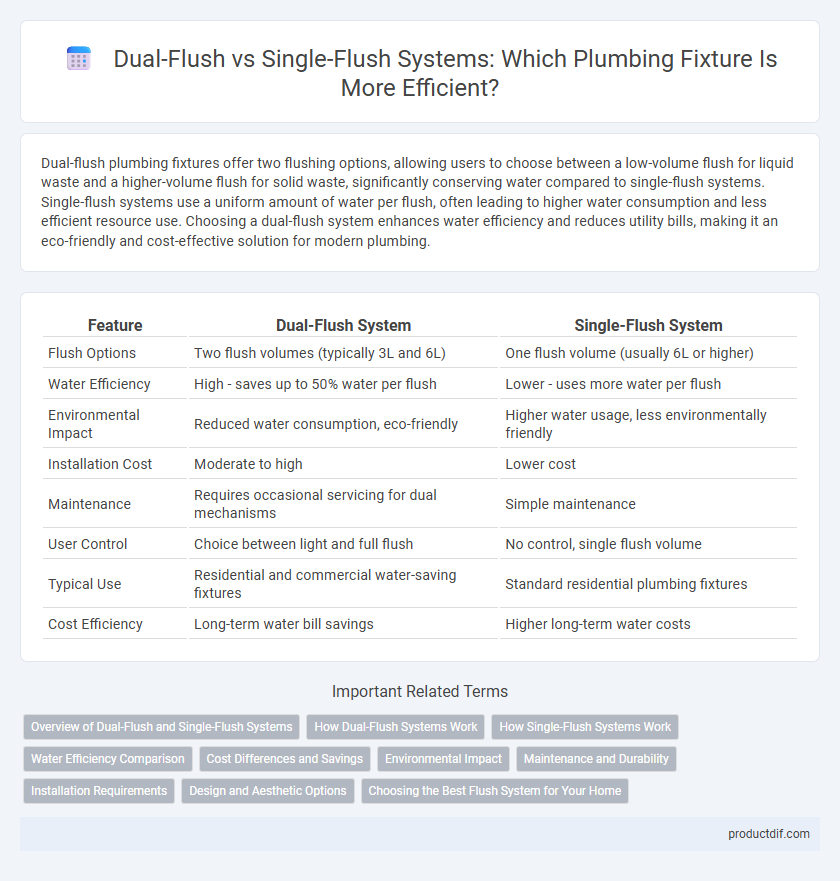Dual-flush plumbing fixtures offer two flushing options, allowing users to choose between a low-volume flush for liquid waste and a higher-volume flush for solid waste, significantly conserving water compared to single-flush systems. Single-flush systems use a uniform amount of water per flush, often leading to higher water consumption and less efficient resource use. Choosing a dual-flush system enhances water efficiency and reduces utility bills, making it an eco-friendly and cost-effective solution for modern plumbing.
Table of Comparison
| Feature | Dual-Flush System | Single-Flush System |
|---|---|---|
| Flush Options | Two flush volumes (typically 3L and 6L) | One flush volume (usually 6L or higher) |
| Water Efficiency | High - saves up to 50% water per flush | Lower - uses more water per flush |
| Environmental Impact | Reduced water consumption, eco-friendly | Higher water usage, less environmentally friendly |
| Installation Cost | Moderate to high | Lower cost |
| Maintenance | Requires occasional servicing for dual mechanisms | Simple maintenance |
| User Control | Choice between light and full flush | No control, single flush volume |
| Typical Use | Residential and commercial water-saving fixtures | Standard residential plumbing fixtures |
| Cost Efficiency | Long-term water bill savings | Higher long-term water costs |
Overview of Dual-Flush and Single-Flush Systems
Dual-flush systems offer two flush options, typically 0.8 gallons for liquid waste and 1.6 gallons for solid waste, promoting water conservation by reducing overall usage. Single-flush systems use a uniform flush volume, generally around 1.6 gallons per flush, leading to higher water consumption compared to dual-flush models. Choosing between these systems depends on balancing water efficiency with installation costs and user preferences.
How Dual-Flush Systems Work
Dual-flush systems operate with two flush options: a lower volume flush for liquid waste and a higher volume flush for solid waste, optimizing water usage. This mechanism uses separate buttons or a split handle to release precise water amounts, conserving up to 67% more water than single-flush systems. Incorporating a dual-flush valve enhances efficiency without compromising performance in modern plumbing fixtures.
How Single-Flush Systems Work
Single-flush plumbing fixtures operate by releasing a fixed volume of water per flush, typically ranging from 1.6 to 3.5 gallons. They use a simple valve mechanism that opens fully when the flush lever is activated, allowing water to flow from the tank into the bowl. This system provides a straightforward, reliable flushing action but lacks the water-saving flexibility found in dual-flush models.
Water Efficiency Comparison
Dual-flush systems offer superior water efficiency by providing two flush options: a lower volume flush for liquid waste and a higher volume flush for solid waste, significantly reducing water consumption compared to single-flush systems that use a fixed amount per flush. Typically, dual-flush toilets use approximately 0.8 to 1.1 gallons per flush (gpf) for liquid waste and 1.6 gpf for solid waste, whereas traditional single-flush toilets consume around 1.6 gpf consistently. This targeted water usage in dual-flush fixtures can result in water savings of up to 20-60% annually, making them a more sustainable choice for reducing household water usage.
Cost Differences and Savings
Dual-flush systems typically have higher upfront costs than single-flush systems due to advanced mechanisms and installation requirements. However, dual-flush toilets offer significant water savings by providing two flush options, reducing water bills substantially over time. Single-flush systems, while cheaper initially, often result in higher long-term water expenses due to consistent water usage per flush.
Environmental Impact
Dual-flush systems significantly reduce water consumption by offering two flush options, typically using 0.8 to 1.1 gallons for liquid waste and 1.6 gallons for solid waste, compared to the consistent 1.6 gallons per flush in single-flush systems. This reduction in water usage lowers the environmental impact by conserving freshwater resources and decreasing the energy required for water treatment and distribution. Implementing dual-flush fixtures in plumbing reduces overall water waste, making them a more sustainable choice for eco-friendly building designs.
Maintenance and Durability
Dual-flush systems typically require more maintenance due to their complex mechanism with separate flush buttons and valves, while single-flush systems boast simpler designs that enhance durability and reduce repair frequency. High-quality dual-flush components may offer longevity comparable to single-flush fixtures but often need routine adjustments to maintain optimal performance. Plumbing fixture longevity depends on material quality and water conditions, with single-flush models generally favored for ease of maintenance in commercial or high-usage environments.
Installation Requirements
Dual-flush systems require compatible toilets with dual-flush mechanisms, often necessitating precise water pressure and a more complex valve installation compared to single-flush systems. Single-flush systems have simpler installation requirements, using standard flush valves compatible with most toilets and plumbing setups. Both systems benefit from professional installation to ensure proper sealing and optimal performance.
Design and Aesthetic Options
Dual-flush systems offer versatile design and aesthetic options with sleek, modern buttons that blend seamlessly into contemporary bathroom fixtures, providing a clean look while promoting water conservation. Single-flush systems tend to have simpler, more traditional designs that suit classic or utilitarian bathroom styles but offer less visual variety. Choosing between dual-flush and single-flush fixtures can significantly impact the overall bathroom ambiance and the integration of eco-friendly technology with stylistic preferences.
Choosing the Best Flush System for Your Home
A dual-flush system offers two flush options--typically 0.8 gallons for liquid waste and 1.6 gallons for solid waste--resulting in significant water savings compared to the single-flush system, which uses a fixed 1.6 gallons per flush. Homeowners aiming to reduce water consumption and lower utility bills benefit from dual-flush toilets due to their efficient design and environmental impact. Single-flush systems, while simpler and generally less expensive upfront, may lead to higher water usage over time, making dual-flush models the preferred choice for sustainable and cost-effective plumbing fixtures.
Dual-flush system vs Single-flush system Infographic

 productdif.com
productdif.com